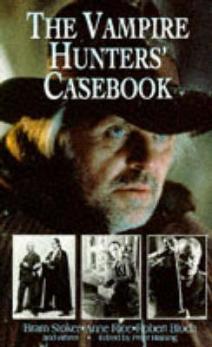
Peter Haining was an experienced anthologist, but this is definitely a mixed bag. His focus is on the vampire hunter rather than the vampire, but his 1996 selection firmly establishes that the vampire is generally the more interesting of the two. The compilation seems to have been thrown together with little care: there is no bibliographic information, and editorially there is merely a short introduction, mainly dealing with film vampire hunters, a longer preface reprinting a section from Bram Stoker’s Dracula in which Van Helsing muses on the nature of the vampire, and a one-page biographical sketch for each contributor.
There is the usual mix of well-known and less well-known authors. The 14 entries, presented in chronological order of writing, vary greatly in quality, and several are extracts from novels, suggesting Haining was hard put to find short stories of sufficient quality. Reinforcing that suspicion, a couple (Robert Bloch’s ‘The Undead’ and Anne Rice’s ‘The Master of Rampling Gate’) do not actually feature vampire hunters. The earliest story is from 1872, an extract from Sheridan Le Fanu’s Carmilla, the latest, was written by Peter Tremayne for the volume. Also represented by excerpts are Sydney Horler’s The Vampire, referred to as ‘The Bloodsucker of Portland Place’ by Haining, and The Night Stalker, by Jeff Rice, abbreviations which make for unsatisfying reads.
The most frequent vampire hunter unsurprisingly is Abraham Van Helsing, who appears in three stories: Peter Haining’s own ‘The Beefsteak Room’ (a bit cheeky to include your own work but it is short), Robert Bloch’s ‘The Undead’, though not in person, and Tremayne’s ‘My Name Upon the Wind’. Not all of the protagonists are vampire specialists but rather are general occult investigators, such as Arabella Kenealy’s Lord Syfret in ‘A Beautiful Vampire’ – he actually subcontracts a chunk of the investigation to the formidable Nurse Marian, who on this evidence deserved a series of her own; Aylmer Vance in ‘Aylmer Vance and the Vampire’ by Claude and Alice Askew, though Haining credits the story to Claude alone; and Seabury Quinn’s Jules de Grandin, who bears a resemblance in his mannerisms to Agatha Christie’s Poirot, in ‘The Man Who Cast No Shadow’.
The best, such as Tremayne’s story set in Ireland during the Protestant Ascendancy (calling a character ‘Draigen’ is rather a giveaway as to its vampiric nature), Manly Wade Wellman’s ‘The Last Grave of Lill Warran’ and Anne Rice’s ‘The Master of Rampling Gate’, evoke an uncanny atmosphere, though Rice brings a romantic yearning to her tale hard to square with the father’s deathbed command that the house should be demolished. The worst is Uel Key’s ‘The Broken Fang’ (1915), which features a dastardly attempt by enemy agents to create a vampire army out of young Englishmen of serving age (reminding me of the over-optimistic scheme for world domination one victim at a time in Plan 9 from Outer Space) but is actually an effort to whip up antipathy towards naturalised Germans living in Britain. Karl Edward Wagner’s ‘Beyond any Measure’ mixes modern-day vampirism with reincarnation, but is let down by its slow pacing. The very best, though one of the shortest, is David J Schow’s ‘A Week in the Unlife’, showing that the vampire hunter is not always an arch rationalist fighting the forces of darkness.
